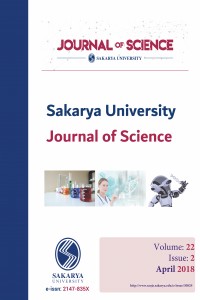Anti-kanser ilacı imatinib’in elektro-oksidasyon prosesi ile gideriminin yüzey yanıt metodu kullanılarak incelenmesi
Keywords
References
- S. Nussbaumer, P. Bonnabry, J. L. Veuthey, S. Felury-Souverain, “Analysis of anticancer drugs: a review,” Talanta, vol. 85, pp. 2265–2289, 2011.
- S. Santana-Viera, S. Montesdeoca-Esponda, Z. Sosa-Ferrera, J. J. Santana-Rodríguez, “Cytostatic drugs in environmental samples: An update on the extraction and determination procedures,” Trends in Analytical Chemistry, vol. 80, pp. 373–386, 2016.
- M. Isodori, M. Lavorgna, C. Russo, M. Kundi, B. Zegura, M. Novak, M. Filipic, M. Misik, S. Knasmueller, M. L. de Alda, D. Barcelo, B. Zonja, M. Cesen, J. Sacncar, T. Kosjek, “Chemical and toxicological characterisation of anticancer drugs in hospital and municipal wastewaters from Slovenia and Spain,” Environmental Pollution, vol. 219, pp. 275–287, 2016.
- S. Mompelat, B. LeBot, O. Thomas, “Occurrence and fate of pharmaceutical products and by-products, from resource to drinking water,” Environment International, vol. 35, pp. 803–814, 2009.
- R. Andreozzi, V. Caprio, C. Ciniglia, M. de Champdoré, R. Lo Giudice, R. Marotta, E. Zuccato, “Antibiotics in the environment: occurrence in Italian STPs, fate, and preliminary assessment on algal toxicity of amoxicillin.,” Environmental Science and Technology, vol. 38, pp. 6832–6838, 2004.
- B. Du, A. E. Price, W. C. Scott, L. A. Kristofco, A. J. Ramirez, C. K. Chambliss, J. C. Yelderman, B. W. Brooks, “Comparison of contaminants of emerging concern removal, discharge, and water quality hazards among centralized and on-site wastewater treatment system effluents receiving common wastewater influent,” Science of the Total environment, vol. 85, pp. 976–984, 2014.
- F. Sopaj, M. A. Rodrigo, N. Oturan, F. I. Podvorica, J. Pinson, M. A. Oturan, “Influence of the anode materials on the electrochemical oxidation efficiency. Application to oxidative degradation of the pharmaceutical amoxicillin,” Chemical Engineering Journal, vol. 262, pp. 286–294, 2015.
- J. Wu, H. Zhang, N. Oturan, Y. Wang, L. Chen, M. A. Oturan, “Application of response surface methodology to the removal of the antibiotic tetracycline by electrochemical process using carbon-felt cathode and DSA (Ti/RuO2–IrO2) anode,” Talanta, vol. 85, pp. 2265–2289, 2011.
- E. Guinea, C. Arias, P. L. Cabot, J. A. Garrido, F. Centellas, E. Brillas, “Mineralization of salicylic acid in acidic aqueous medium by electrochemical advanced oxidation processes using platinum and boron-doped diamond as anode and cathodically generated hydrogen peroxide,” Water Research, vol. 42, pp. 499-511, 2008.
Evaluation of anti-cancer drug ımatinib removal by electro-oxidation process using response surface method
Abstract
The pharmaceuticals which are found in the wastewater
treatment effluents of the companies that produce cancer drug have become a
serious fear for biotic living beings as they are toxic. Although the
concentration of pharmaceuticals in surface water and wastewater are in low
levels like µg/L and ng/L levels, because of their chronical effects they are
needed to be removed from water immediately. They are not amenable to
conventional biological treatment due to their toxicity even at low
concentrations. Therefore, powerful oxidation methods have to be researched to
remove them from waters, thus avoiding their potential adverse health effects
on humans and animals. Especially electrochemical processes to purify such
micro pollutants have attracted attention as very successful methods. In this
study, electro-oxidation of Imatinib (IMT) has been studied. Ti/RuO2
electrode which has chemical and elevtrochenical stability has been used. In
order to determine their operation conditions, process optimization has been
done by using Response Surface Method (RSM).
Keywords
References
- S. Nussbaumer, P. Bonnabry, J. L. Veuthey, S. Felury-Souverain, “Analysis of anticancer drugs: a review,” Talanta, vol. 85, pp. 2265–2289, 2011.
- S. Santana-Viera, S. Montesdeoca-Esponda, Z. Sosa-Ferrera, J. J. Santana-Rodríguez, “Cytostatic drugs in environmental samples: An update on the extraction and determination procedures,” Trends in Analytical Chemistry, vol. 80, pp. 373–386, 2016.
- M. Isodori, M. Lavorgna, C. Russo, M. Kundi, B. Zegura, M. Novak, M. Filipic, M. Misik, S. Knasmueller, M. L. de Alda, D. Barcelo, B. Zonja, M. Cesen, J. Sacncar, T. Kosjek, “Chemical and toxicological characterisation of anticancer drugs in hospital and municipal wastewaters from Slovenia and Spain,” Environmental Pollution, vol. 219, pp. 275–287, 2016.
- S. Mompelat, B. LeBot, O. Thomas, “Occurrence and fate of pharmaceutical products and by-products, from resource to drinking water,” Environment International, vol. 35, pp. 803–814, 2009.
- R. Andreozzi, V. Caprio, C. Ciniglia, M. de Champdoré, R. Lo Giudice, R. Marotta, E. Zuccato, “Antibiotics in the environment: occurrence in Italian STPs, fate, and preliminary assessment on algal toxicity of amoxicillin.,” Environmental Science and Technology, vol. 38, pp. 6832–6838, 2004.
- B. Du, A. E. Price, W. C. Scott, L. A. Kristofco, A. J. Ramirez, C. K. Chambliss, J. C. Yelderman, B. W. Brooks, “Comparison of contaminants of emerging concern removal, discharge, and water quality hazards among centralized and on-site wastewater treatment system effluents receiving common wastewater influent,” Science of the Total environment, vol. 85, pp. 976–984, 2014.
- F. Sopaj, M. A. Rodrigo, N. Oturan, F. I. Podvorica, J. Pinson, M. A. Oturan, “Influence of the anode materials on the electrochemical oxidation efficiency. Application to oxidative degradation of the pharmaceutical amoxicillin,” Chemical Engineering Journal, vol. 262, pp. 286–294, 2015.
- J. Wu, H. Zhang, N. Oturan, Y. Wang, L. Chen, M. A. Oturan, “Application of response surface methodology to the removal of the antibiotic tetracycline by electrochemical process using carbon-felt cathode and DSA (Ti/RuO2–IrO2) anode,” Talanta, vol. 85, pp. 2265–2289, 2011.
- E. Guinea, C. Arias, P. L. Cabot, J. A. Garrido, F. Centellas, E. Brillas, “Mineralization of salicylic acid in acidic aqueous medium by electrochemical advanced oxidation processes using platinum and boron-doped diamond as anode and cathodically generated hydrogen peroxide,” Water Research, vol. 42, pp. 499-511, 2008.
Details
| Primary Language | Turkish |
|---|---|
| Subjects | Environmental Engineering |
| Journal Section | Research Articles |
| Authors | |
| Publication Date | April 1, 2018 |
| Submission Date | August 29, 2017 |
| Acceptance Date | March 29, 2018 |
| Published in Issue | Year 2018 Volume: 22 Issue: 2 |
Cite
This work is licensed under a Creative Commons Attribution-NonCommercial 4.0 International License.


